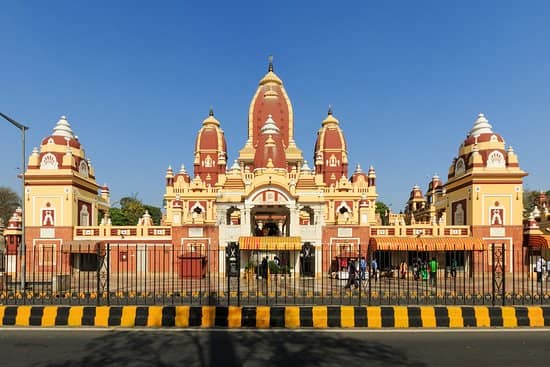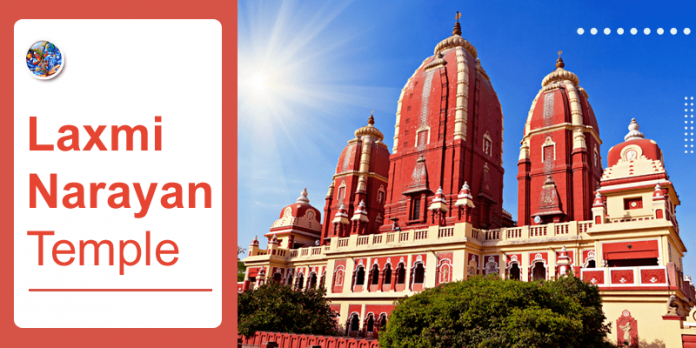No matter what religion you are a part of, you always need a safe place to “connect” with your God. That’s where temples step in, welcoming devotees with open arms, helping them achieve peace and harmony. Plus, they symbolize the myths and stories that are a part of popular folklore. Temples even serve as a source for community welfare.
When it comes to temples in Delhi, the Laxmi Narayan Temple stands out. Also known as Birla Temple or Birla Mandir, it is located in the heart of Delhi. Whether you are a resident of Delhi or visiting Delhi for work or leisure, visiting Laxmi Narayan Temple should be on your to-do list. Besides religious significance, it has some architectural value as well.
From the stories inscribed on walls to works celebrating the emperors of the past, it has everything to keep you hooked. If that has piqued your curiosity, let’s walk you through everything you need to know about the temple. Read on to stay enlightened.
Laxmi Narayan Temple: History, Architecture & Nearest Visiting Places
About Laxmi Narayan Temple
You should visit the Laxmi Narayan Temple to calm your mind. You will find yourself being in the presence of God and a boundless energy. This is one of the reasons why the Laxmi Narayan temple is one of the most visited places in the capital. Also, it is among the largest temples in the capital, with an area coverage of 7.3 acres. It is decorated with shrines and Hindu sculptures and features a garden and a separate section for Geeta readings.
Jugal Kishore Birla is credited with constructing the Birla Mandir Delhi way back in the 1930s. The inauguration was done by Mahatma Gandhi in 1939. But not everyone knows that he only agreed to inaugurate on the condition, i.e. the temple will welcome everyone, regardless of caste, color, or religion. The point was to promote social harmony.
The architecture of the Laxmi Narayan temple is mesmerizing, making it one of the most influential temples that the country has seen. True to its name, the house of worship is dedicated to Laxminarayana, which is another name for Vishnu when he is with Lakshmi. The works and architecture of the temple will give you an idea of how Hindus perceive time and the world. It consists of interpretations from the Sat Yug to the Kal Yug in the universal time cycle. According to Hindu belief, we are living in Kaal Yug or Kali Yug, which marks the end of the world. Strange but true, it is the worst of all the four yugas, dominated by sin, confusion, conflict, and negativity. Once it’s over, the cycle will begin again and continue as long as it can. This idea can be seen on the walls and the language of the temple.
The Laxmi Narayan Temple Delhi celebrates rituals and festivals, notably Janmashtami and Diwali, with enthusiasm. On these special occasions, you can see devotees flocking to the temple to seek plenary indulgence and blessings.
How to Get to Laxmi Narayan Temple?

With proper directions, accessing the Laxmi Narayan Temple is easy and quick. It lies on the Blue Line. So, all you have to do is find your way to the color. The R K Ashram Marg, Patel Chowk, and Shivaji Stadium metro stations are closest to the location. From each metro station, there is a 20 mins walk to the temple.
If you plan to take bus routes, you will find your way easily, but it may take some time. The regular bus commute involves buses numbered 310, 610, 610A, 624ASTL, and 988. The temple is located on Mandir road, close to Cannaught place. If you manage to reach there through the metro, you can easily get an auto-rickshaw or taxi.
- Official address: Mandir Marg, Near Gole Market, Gole Market, New Delhi, Delhi 110001
- Timing: The Laxmi Narayan Temple Delhi timings are: from 6 am to 12 pm and then again from 4 pm to 9 pm.
History of Laxmi Narayan Temple
The construction of the Laxminarayan Temple began as early as 1933. Think of it as a brainchild of an industrialist and philanthropist, Baldeo Das Birla and his son Jugal Kishore Birla. That’s why they call it the “Birla Temple”. One lesser-known fact is that Jay Maharaj Udaya Bhanu Singh laid out the first stones of the temple under the guidance of Pandit Vishwanath Shastri. This temple was the first one to be built among the chain of temples that followed around the country in locations like Kolkata, Himachal, Chamba, and more.
The Building and the Architecture
The Swadeshi Movement was a source of inspiration and self-pride. It even led to the ‘Modern Indian Architecture Movement’ led by Sris Chandra Chatterjee. He happened to be a temple architect who could capture the ideas and essence of the country in his creations. He was open to ideas, innovations, technologies and modern materials. Though the movement did not boycott any alien sources, it focused on getting inspired. But more so, it focused on developing those inspirations with a touch of Indian culture.
The temple is a three-storied building where you will find two additional buildings dedicated to Vishnu and Buddha. The Nagara style of architecture inspires it, and these suggest the previous and the present universal cycles, called Kaal Chakra. Acharya Vishvanath Shastri led over a hundred craftsmen from Benares who carved icons and depictions on the walls. The highest point of the temple is 160 feet, and it has its doors facing east.
Inside the temple
When you find yourself inside this famous temple in Delhi, you will be greeted by some magnificent idols and the carvings on the building walls. One of the first things that you may notice are the statues of Shivaji and Chandragupta Maurya. There is a room reserved wherein you can read verses from the Geeta. Just outside the premises, lovely gardens with artificial waterfalls are there for unwinding. Moreover, there is a Dharmashala where you can get blessings through the prasad or bhog. A small section is reserved for people who want to buy an ornament for the daily puja, alongside flowers and incense.
Best Places to visit near Laxmi Narayan Temple

Looking for more historical places close to the Laxmi Narayan Temple? Visit Kalkaji. It’s home to the Lotus temple, which is dedicated to promoting peace and harmony. The outside of the temple is pretty, with stunning gardens featuring exotic flowers and plants.
Suppose you are looking for a shopping complex or just a place to eat and have fun. Then you should come back to Connaught Place. You will find several cafes and restaurants in and around the area. Also, feel free to ride e-bikes here and roam around the place with your friends. There are small book shops at almost every corner where you can explore books across genres. You can even try Oxford, a huge, fascinating book museum.
Another major tourist spot near the Laxmi Narayan Temple is the India Gate. Visitors from different parts of the world love to visit this place. It is a war memorial honoring the 90,000 soldiers who fought with the British in the First World War. The gate is designed by Sir Edwin Lutyens, an architect specializing in war memorials.
Jantar Mantar is another tourist hotspot situated near the Laxmi Narayan Temple. A foundation of Raja Jai Singh II, it represents astronomical instruments that can be used without any visual support. Initially, there were five Jantar Mantar, four of which were taken down before the sepoy mutiny in 1957. The instruments featured here include:
- Rama Yantra
- Samrat Yantra
- Jai Prakash Yantra
- Chakra Yantra
- Disha Yantra
Conclusion
New Delhi is called the capital for a reason. It is your best bet to learn the history and culture of the country. Moreover, you will have the experience of a metro city in its true sense. It is home to the Laxmi Narayan Temple, one of the most frequented tourist sites in Delhi. And right next to the temple, you’ll find an excellent blend of religion, culture, and modernity.
People are also reading:




